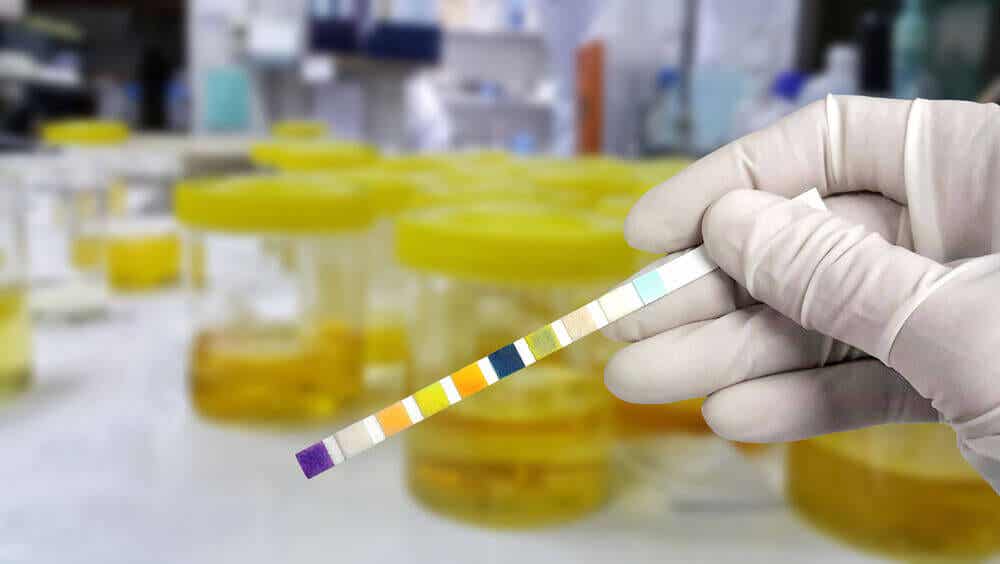What is Urine pH?


Written and verified by the doctor Karina Valeria Atchian
Urine samples are a simple way for doctors to test the health of your kidneys and other parts of the body. Also, some other things they study are the hydrogen potential, or urine pH.
Since ancient Greece, urine has been a diagnostic method. Color, turbidity, odor, volume, viscosity, and even sweetness have been measured. Then, from the invention of the microscope in the seventeenth century, specialists started studying urinary sediment. Finally, it was added as a routine study method for medical check-ups.
Nowadays, urine tests are an accessible, inexpensive, non-invasive, and easily collected study that allows us to check for various conditions. For example, one of the parameters that urinary samples study is urine pH.
The kidney functions normally thanks to multiple cellular processes. Also, if any of these functions are disturbed, it may threaten your health.
We’ll start with some general concepts to understand urine pH better.
What is urinalysis for?
As we have mentioned, urinalysis is a non-invasive study method. In addition, it fulfills lots of functions to detect and monitor different conditions:
- Monitor the evolution of known kidney disease
- Diagnose acute or chronic kidney disease in patients with other suspected symptoms
- Find kidney diseases in a patient without apparent symptoms
- General disease marker

What parameters of urine are studied?
In a urinalysis, various parameters can be studied, including the following:
- Glomerular filtration rate: The main measure of kidney function
- Urinary sediment: Erythrocytes, leukocytes, casts, and crystals in urine
- Proteinuria: Abnormal elimination of protein in the urine
- Urine pH
- Changes in urinary volume: Oliguria, anuria, polyuria
- The presence of glucose in urine
- Electrolyte abnormalities: Sodium, chloride, potassium, calcium
What is urine pH?
This concept refers to the concentration of hydrogen ions in urine. Also, it reflects the degree of acidity. Its normal value is between 4.5 and 8.
Additionally, the complex system that regulates blood pH is made up of three parts that work at the same time:
- Kidneys
- Lungs
- A chemical buffer system
The way that kidneys contribute to the balance of the pH in the blood is through the elimination or retention of urine. Also, it can be either acidic or alkaline substances, depending on what your body needs. However, the goal is always to keep the blood’s pH at a healthy level, around 7.4.
Here, we can classify urine ph into three grades:
- Acidic urinary pH when the value is low: less than 5.5.
- Alkaline urinary pH when it’s high: above 7.
- If the pH is 7, it’s neutral.
Whenever there’s a different pH, specialists should consider the patient’s blood and medical history. In addition, they should look at renal function, the presence or absence of urinary infections, diet, and other factors.

Check this out: Understand Your Metabolism to Effectively Lose Weight
The causes of acidic urine
There’s a long list of causes that cause acidic urine. For example, some of these are:
- Chronic obstructive pulmonary disease or emphysema
- Diabetes mellitus
- Starvation
- Dehydration
- Diarrhea
- Presence of acid-producing bacteria, like Escherichia coli.
- High protein diet
- Cranberry juice
- Medications
The causes of alkaline urine
On the other hand, the possible causes of alkaline urine are:
- Hyperventilation
- Vomiting
- Renal tubercular acidosis
- Presence of urease-producing bacteria
- Vegetarian diet
- Old samples
You may be interested: What Foods Should You Eat if You Suffer from Gallstones?
What’s the ideal urine sample?
Generally, the first urine in the morning is the best sample for a urine test. Usually, it’s a concentrated sample that guarantees the detection of chemicals and elements that you might not find in a random sample.
Then, after collection, you should bring it to a lab right away for analysis. However, if you can’t deliver it right away, you should refrigerate it between 25-46ºF. This way, you can avoid bacterial growth and metabolism of the sample. In addition, it won’t change the pH of the sample.
The importance of measuring urine pH
Studying urine samples is inexpensive and easy to get. Also, it lets us test many of the body’s metabolic functions. For example, we know that both a low and high pH can cause different types of kidney stones.
Finally, with the rest of the urinary parameters, pH is an important element when doing different tests and follow-ups.
All cited sources were thoroughly reviewed by our team to ensure their quality, reliability, currency, and validity. The bibliography of this article was considered reliable and of academic or scientific accuracy.
- Lozano, T. C. (2016). Examen general de orina: una prueba útil en niños. Revista de la Facultad de Medicina, 64(1), 137-47. http://www.scielo.org.co/scielo.php?script=sci_arttext&pid=S0120-00112016000100019
- Maalouf, N. M., Cameron, M. A., Moe, O. W., & Sakhaee, K. (2010). Metabolic basis for low urine pH in type 2 diabetes. Clinical Journal of the American Society of Nephrology : CJASN, 5(7), 1277–1281. https://pubmed.ncbi.nlm.nih.gov/20413437/.
- Miki, A., Hashimoto, Y., Tanaka, M., Kobayashi, Y., Wada, S., Kuwahata, M., … & Fukui, M. (2017). Urinary pH reflects dietary acid load in patients with type 2 diabetes. Journal of Clinical Biochemistry and Nutrition, 61(1), 74-77. https://www.jstage.jst.go.jp/article/jcbn/61/1/61_16-118/_article/-char/ja/
- Milo, S., Thet, N. T., Liu, D., Nzakizwanayo, J., Jones, B. V., & Jenkins, A. T. A. (2016). An in-situ infection detection sensor coating for urinary catheters. Biosensors and Bioelectronics, 81, 166-172. https://www.sciencedirect.com/science/article/pii/S095656631630166X
- Ordaz, G., Dagà, U., Budia, A., Pérez-Lanzac, A., Fernández, J. M., & Jordán, C. (2023). Urinary pH and antibiotics, choose carefully. A systematic review. Actas Urológicas Españolas (English Edition), 47(7), 408-415. https://www.sciencedirect.com/science/article/pii/S2173578623000112
- Pfortmueller, C. A., Pauchard-Neuwerth, S. E., Leichtle, A. B., Fiedler, G. M., Exadaktylos, A. K., & Lindner, G. (2015). Primary hyperventilation in the emergency department: a first overview. PLoS One, 10(6), e0129562. https://journals.plos.org/plosone/article?id=10.1371/journal.pone.0129562
- Siener, R., Bitterlich, N., Birwé, H., & Hesse, A. (2021). The impact of diet on urinary risk factors for cystine stone formation. Nutrients, 13(2), 528. https://www.mdpi.com/2072-6643/13/2/528
- Wald, R. (21 de febrero de de 2024). Urinalysis in the diagnosis of kidney disease. https://www.uptodate.com/contents/urinalysis-in-the-diagnosis-of-kidney-disease#H1565292256
- Yang, S. W., Lin, Y. J., Cheng, Y. W., Chen, Y. Y., & Chen, W. L. (2021). Low urine pH is a risk factor for low muscle mass: A new way to predict sarcopenia. Geriatrics & Gerontology International, 21(10), 944-949. https://onlinelibrary.wiley.com/doi/abs/10.1111/ggi.14269
This text is provided for informational purposes only and does not replace consultation with a professional. If in doubt, consult your specialist.








